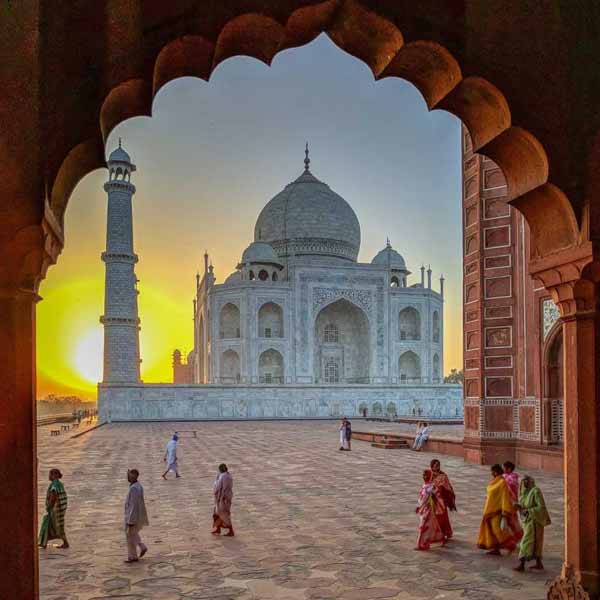“The embodiment of all things pure”, said Rudyard Kipling on Taj Mahal’s beauty and that is no wordplay as the Taj is undoubtedly a pure epitome of beauty. It is an immortal poem in white marble and is the finest expression of love of an emperor for his queen. Located on a bank of River Yamuna, it was built by Mughal Emperor Shah Jahan in memory of his beloved wife and Queen Mumtaz Mahal in 1631, who died giving birth to his child and whose last wish to her husband was “to build such a tomb in her memory which the world has never seen before.” It took over 17 years, 22000 workers and 1000 elephants to build the wonderful mausoleum.
The Taj Mahal is one of the three World Heritage Sites in India. Set in a serene Mughal Garden the monument stands on a raised marble platform, with its back towards Yamuna River. The four sides of the Taj Mahal show a perfect symmetry and feature impressive vaulted arches embellished with Pietra Dura scrollwork, and verses from the Quran in calligraphy using inlaid jasper. This architectural masterpiece is one of the most frequented places in India by photographers and foreign tourists. The Taj Mahal looks as immaculate today as when it was first built, leaving the onlookers mesmerized.

Location of the Taj Mahal
The Taj Mahal is located in Agra, in the north Indian state of Uttar Pradesh. It is located on the banks of the River Yamuna and is easily accessible by road.
How to Reach the Taj Mahal
Agra is about 200 km from Delhi (165 if you use the Yamuna Expressway) and is easily accessible by flights, roadways and train services. The travel time from Delhi to Agra by road is around 3 hours.
In order to minimize the effects of pollution, vehicles are not allowed in the immediate vicinity of the Taj Mahal. Cars and buses have to park in parking lots a short distance away from the mausoleum complex and tourists can board non-polluting electric buses to reach the Taj Mahal.
You can travel from Delhi to Agra, see the Taj Mahal, and return in one day. However, if you wish to see more of the sights of Agra and shop in the city's markets, then it is a good idea to stay overnight.
Best Time To Visit the Taj Mahal
The best time to visit the Taj Mahal is in the autumn, winter and spring months from October to February. The peak summer months of May to July are best avoided because of the hot weather. The months of October and November, after the monsoon, offer the sight of the Taj at its mesmerising best, as the gardens are lush with greenery and the Yamuna river flows proudly past the Taj Mahal, swollen with post-monsoon rain. Both these factors enhance the overall experience of viewing the Taj Mahal.
Taj Mahal Timings
The Taj Mahal complex is open to visitors from sunrise to sunset (6 a.m. to 7 p.m.) on all weekdays, with the exception of Friday. On Fridays, the mosque in the Taj Mahal complex is open for prayers from 12 noon to 2 p.m. At this time, tourists are not permitted to enter the complex.
On full-moon nights, and one night before and after a full-moon, the Taj Mahal complex is open for visitors who wish to view the Taj by moonlight - a truly spectacular sight. The moonlight viewing sessions are not permitted during the month of Ramadan and on Fridays.
Now, the Archeological Survey of India has given its nod to open the east and west gates of the spectacular monument half an hour before sunrise and will be shut half an hour before sunset. It is for the convenience of tourists who want to view the Taj Mahal during sunrise. The ticket booking counters will be opened an hour before sunrise and will be shut 45 minutes before sunset. The timings of the south gate will be same. It will open at 8 am and will close at 5 pm.
While travelling to the Taj Mahal complex, do note that security restrictions apply at the complex and the only items a tourist may carry into the grounds are the following: mobile phones, still cameras, small video cameras, small purses carried by ladies, and water in transparent bottles.